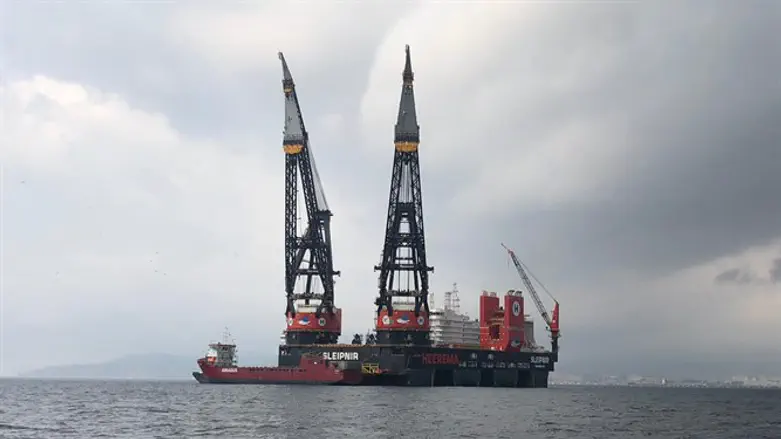
The largest energy project in the history of the State of Israel is reaching its final stage in advance of first gas production which will supply customers in Israel and the region before the end of the year.
The production decks (topsides), comprising five different production units, are expected to arrive offshore Israel in the coming days, on four barges. Also arriving will be the world’s largest offshore Semi-Submersible Crane Vessel (SSCV), which will be situated by the platform jacket, installed at the beginning of the year. The Crane vessel is much larger than the platform and will be visible from the shore.
The crane vessel will install each of the topside decks, a process that will take approximately four weeks, after which the crane vessel will leave the area. The installation process and start-up process will be accompanied by several vessels, the number of which will be gradually reduced as we approach first gas. By order of the Knesset’s Foreign Affairs and Security Committee, a radius of 3 km around the platform is prohibited to unauthorized maritime traffic, for reasons of security and safety.
The Leviathan Platform will be set 10 kilometers offshore, at a water depth of 86 meters, and the height of the topsides from sea level to the top level is 47 meters. The platform boom, which reaches a height of 130 meters above sea level, is part of the platform safety system.
The topsides will house the platform’s gas processing facilities, accommodations for the team of workers, work areas and helipad. The flare located at the tip of the platform boom is part of the platform’s safety systems and is designed to prevent hydrocarbon emissions into the atmosphere. In addition, the topsides will contain all the utilities required to operate the platform including power generation, water desalination and waste treatment. In essence, the platform is not dependent on onshore facilities for any of its utility needs.
The crane vessel is equipped with two cranes, with a lifting capacity of up to 10,000 tons each. It is 220 m in length, 102 m in width, and the height from sea level to the top of its cranes is 195 making it’s the largest crane vessel in the world. The crane vessel specializes in installing offshore facilities and has unique deep-water working capability.
After connecting and assembling the topside units of the platform, Noble Energy will start a series of commissioning tests before initiating commercial gas flow to the domestic market before the end of 2019.
Connecting the Leviathan pipeline will make it possible for the Israeli energy sector to be based almost exclusively on electricity generated by natural gas, leading to a significant reduction in pollution and improved air quality in Israel.
Noble Energy has discovered 40 trillion cubic feet (Tcf) of recoverable natural gas resources in the Eastern Mediterranean. The Leviathan field – holding 934 BCM (33 Tcf) of resources in place (605 BCM/22 Tcf recoverable) was discovered in December 2010, 125 kilometers west of Haifa and was one of the largest natural gas finds in the world in the last decade. The Leviathan Partnership invested $3.75 billion in development of the reservoir.
The first phase of the Leviathan development included drilling four production wells at an average depth of 5 kilometers below sea level. Each well has a production capacity of 300 million cubic feet of natural gas per day (MMcf/d), with a total annual production capacity of around 12 billion cubic meters (Bcm) – more than doubling the quantity of natural gas produced in Israel today.
Natural gas from the reservoir will be transmitted through two 120-kilometer subsea pipelines directly to the Leviathan Platform. Natural gas will be processed at the platform before the treated gas flow from the platform through a northern entry pipeline connected to the INGL (Israel Natural Gas Lines) national gas transmission system, as defined in the National Outline Plan.